[press release]
Special Star Wars-Themed Stamps From Royal Mail Mark The Final Instalment Of The Skywalker Saga
- Royal Mail issues the third and final stamp set in their Star Wars-themed collection [November 26th]
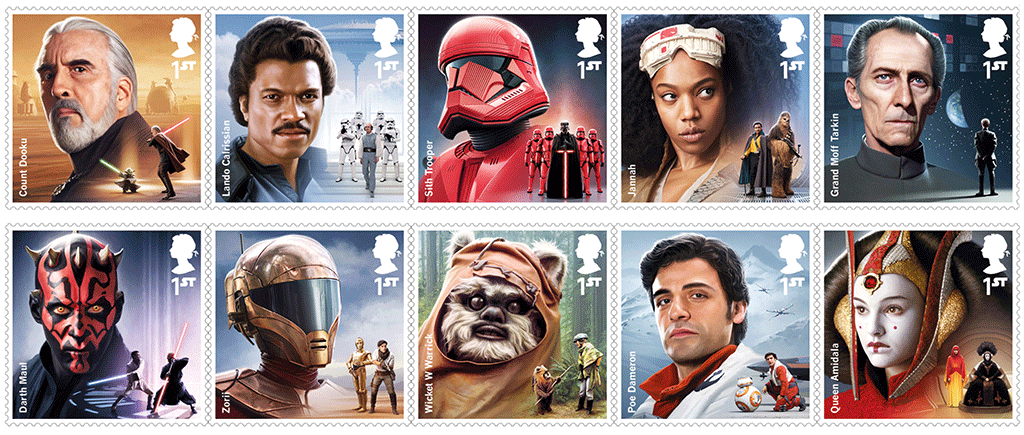
- The new set includes 10 character-themed stamps, featuring three brand new characters from the forthcoming film, Star Wars: The Rise of Skywalker
- Characters featured on the stamps, from the highly anticipated final instalment in the Skywalker saga, are: Jannah; Zorii Bliss; Lando Calrissian; Poe Dameron; and the all-new Sith Trooper
- The new set also features other classic characters from the Skywalker saga including Count Dooku; Grand Moff Tarkin; Darth Maul; the Wicket the Ewok; and Queen Amidala
- Completing the set are six further stamps presented in a miniature sheet, illustrating some of the most iconic starships in the galaxy: Poe’s X-wing fighter; Jedi starfighter; Slave I; TIE silencer; Podracers; and speeder bikes
- The artwork on the stamps feature original illustrations by British artist Malcolm Tween, who also designed the hugely popular Star Wars stamp sets issued in 2015 and 2017
- Each stamp features a secondary character or scene illustrated by Tween especially for the stamps
- The style of the ‘1st’ value on each of the stamps replicates the iconic font used for the films
- A full set of all 16 stamps, available in a Presentation Pack, retails at £12.00
- The stamps, and other collectible products, can be pre-ordered now at www.royalmail.com/starwars and by phone on 03457 641 641
- The stamps will be available on general sale at 7,000 Post Offices across the UK from 26 November 2019
Royal Mail has revealed the images of the final set of stamps in its own Star Wars-themed collection.
The 16-stamp set will mark the upcoming release of Star Wars: The Rise of Skywalker – which is in cinemas from the 19th December – and features characters and iconic vehicles from the Skywalker saga.
Ten character stamps feature: Count Dooku; Lando Calrissian; Sith Trooper; Jannah; Grand Moff Tarkin; Darth Maul; Zorii Bliss; Wicket Warrick; Poe Dameron; and Queen Amidala.
Character-themed stamps making their debut in Royal Mail’s Star Wars: The Rise of Skywalker stamp set are Jannah, Zorii Bliss and the red armoured Sith Troopers.
The characters of Count Dooku and Grand Moff Tarkin, are both included in the new set.
Art of the Ewok character, Wicket Warrick, as well as the character Jannah, are also included on the stamps.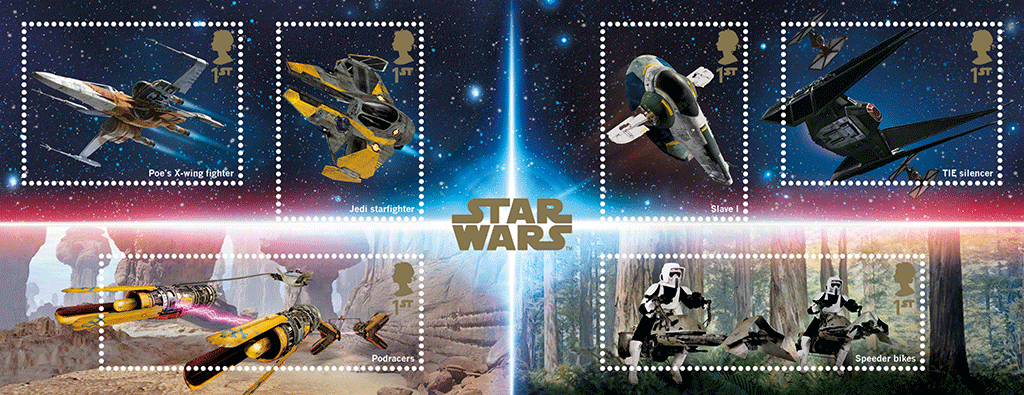
Completing the set are six stamps featuring some of the most iconic vehicles in the Star Wars galaxy including a Podracer and Slave I. Poe’s X-wing fighter; Jedi starfighter; TIE silencer; and speeder bikes also make an appearance.
All 10 character stamps are original, exclusive illustrations by digital artist and Star Wars fan Malcolm Tween. Tween blended the main images with background scenes to create striking and hyper-realistic montages. Tween also designed the hugely popular 2015 and 2017 Star Wars stamp issues.
As with the previous two issues, the style of the ‘1st‘ value on each of the stamps will replicate the iconic font used for the films.
Philip Parker, Royal Mail, said: “Once again Malcolm Tween takes us on a journey across the Star Wars galaxy with extraordinary artwork of characters old and new. The stamps are miniature masterpieces and a fitting tribute to mark the end of the Skywalker saga.”
The full set of 16 stamps, available in a Presentation Pack, retails at £12.00.
The stamps and a range of collectible products are available to pre-order now at www.royalmail.com/starwars and by phone on 03457 641 641.
The stamps will be available on general sale at 7,000 Post Offices across the UK from 26 November.
Stamp-by-stamp:
 Count Dooku
Count Dooku
The sinister and elegant Count Dooku trained as a Jedi Master but joined Darth Sidious as a Sith. Working secretly with Sidious, he leads a droid army against the Republic and initiates the deadly Clone Wars at the Battle of Geonosis, where he engages in a lightsaber battle with Jedi Master Yoda. Sidious betrays Dooku, and the Count is killed by Anakin Skywalker.
Lando Calrissian
 The one-time owner of the “fastest ship in the galaxy”, the Millennium Falcon, Lando Calrissian was a gambler and a smuggler who lost the Falcon in a game of sabacc to Han Solo. Later the administrator of a sophisticated resort on Bespin, Cloud City, he allies himself with the Empire before joining the Rebel Alliance and helping to destroy the second Death Star.
The one-time owner of the “fastest ship in the galaxy”, the Millennium Falcon, Lando Calrissian was a gambler and a smuggler who lost the Falcon in a game of sabacc to Han Solo. Later the administrator of a sophisticated resort on Bespin, Cloud City, he allies himself with the Empire before joining the Rebel Alliance and helping to destroy the second Death Star.
Sith Trooper
 Inspired by the power of a dark and dangerous legacy, the Sith troopers are Kylo Ren’s new breed of highly skilled soldiers. Trained to elite level, these fearsome warriors can handle close-combat blades and blaster rifles as well as long-range heavy artillery. The Sith troopers are to be employed in the First Order’s final push for ultimate galactic domination.
Inspired by the power of a dark and dangerous legacy, the Sith troopers are Kylo Ren’s new breed of highly skilled soldiers. Trained to elite level, these fearsome warriors can handle close-combat blades and blaster rifles as well as long-range heavy artillery. The Sith troopers are to be employed in the First Order’s final push for ultimate galactic domination.
Jannah
 Armed with weapons such as an energy bow and a grapple hook, Jannah is the honourable leader of a fierce band of warriors from an oceanic moon. Jannah is athletic and superbly skilled at archery and riding. She joins legendary heroes such as Lando Calrissian and Chewbacca in the fight against the evils of the First Order.
Armed with weapons such as an energy bow and a grapple hook, Jannah is the honourable leader of a fierce band of warriors from an oceanic moon. Jannah is athletic and superbly skilled at archery and riding. She joins legendary heroes such as Lando Calrissian and Chewbacca in the fight against the evils of the First Order.
 Grand Moff Tarkin
Grand Moff Tarkin
Wilhuff Tarkin became the Emperor’s first Grand Moff, a title given to a governor who rules over star systems that show signs of rebelliousness. Tarkin commanded the Death Star, a superweapon employed against whole planets to demonstrate his maxim of “ruling through fear of force”. Tarkin dies on the Death Star when it is obliterated by the Rebel Alliance.
Darth Maul
 A Zabrak with head horns and face tattoos, Maul is trained in the dark arts as a Sith warrior by Darth Sidious. He emerges from his training on Tatooine and confronts Jedi Qui-Gon Jinn and Obi-Wan Kenobi. In this battle, Jinn is killed, while Maul is sliced in two at the waist. However, he manages to survive and fights in the Clone Wars on robotic legs.
A Zabrak with head horns and face tattoos, Maul is trained in the dark arts as a Sith warrior by Darth Sidious. He emerges from his training on Tatooine and confronts Jedi Qui-Gon Jinn and Obi-Wan Kenobi. In this battle, Jinn is killed, while Maul is sliced in two at the waist. However, he manages to survive and fights in the Clone Wars on robotic legs.
 Zorii Bliss
Zorii Bliss
Zorii Bliss is a tough spice runner from the snowy planet Kijimi. Armed with twin blaster pistols and wearing a visored helmet to hide her face, Zorii just wants to keep her business to herself. But even streetwise scoundrels such as Zorii are forced to take sides in the increasingly high-stakes war between the First Order and the Resistance.
 Wicket Warrick
Wicket Warrick
An Ewok scout and warrior, Wicket W. Warrick befriends Leia Organa on his homeworld, the forest moon of Endor. The peaceful planet has become the site of an Imperial generator that powers the energy shield protecting the second Death Star. Using only simple weapons and traps, Wicket and his fellow Ewoks help Leia and the Rebel Alliance defeat the Empire during the battle of Endor.
 Poe Dameron
Poe Dameron
Ace pilot Poe Dameron is a highly skilled member of the Resistance. Assisted in his customised T-70 X-wing fighter by his trusty droid, BB-8, he leads a daring raid to find a weak spot in Starkiller Base. Preferring action to passivity, he clashes with the leadership of the Resistance over his desire to strike at the First Order but remains at the heart of any battle.
 Queen Amidala
Queen Amidala
At the age of 14, Padmé Amidala becomes the monarch on her planet Naboo. A skilled diplomat and fighter, she goes on to represent Naboo as its senator on Coruscant, where she falls in love with a dashing young Jedi, Anakin Skywalker. Witnessing Anakin’s fall to the dark side, Amidala is forced to flee after she becomes pregnant with their twins, Luke and Leia.
Star Wars: The Rise of Skywalker is released in cinemas on 20 December.

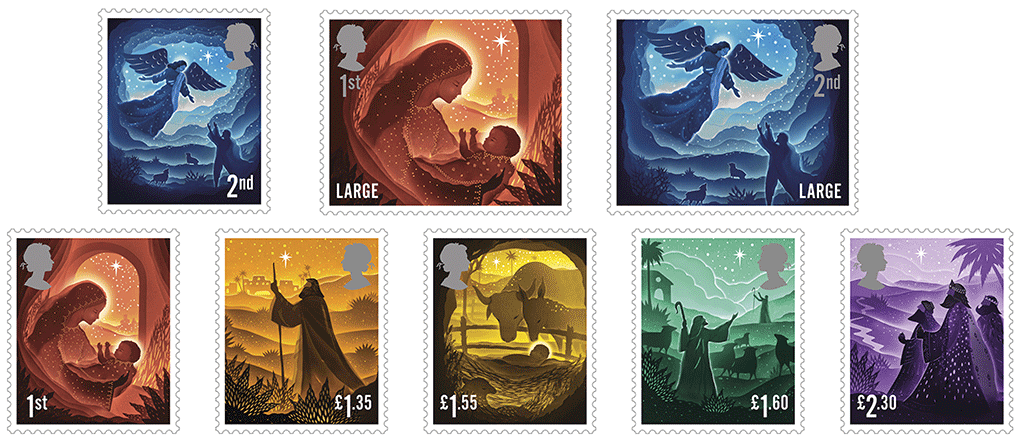
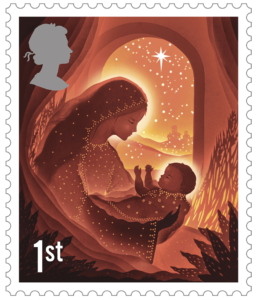 Annunciation, the journey of the Magi and the birth of Jesus Christ.
Annunciation, the journey of the Magi and the birth of Jesus Christ.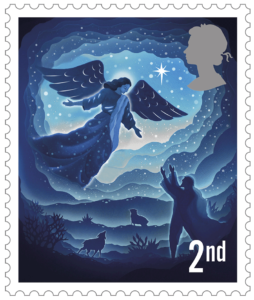 The History of Christmas Cards
The History of Christmas Cards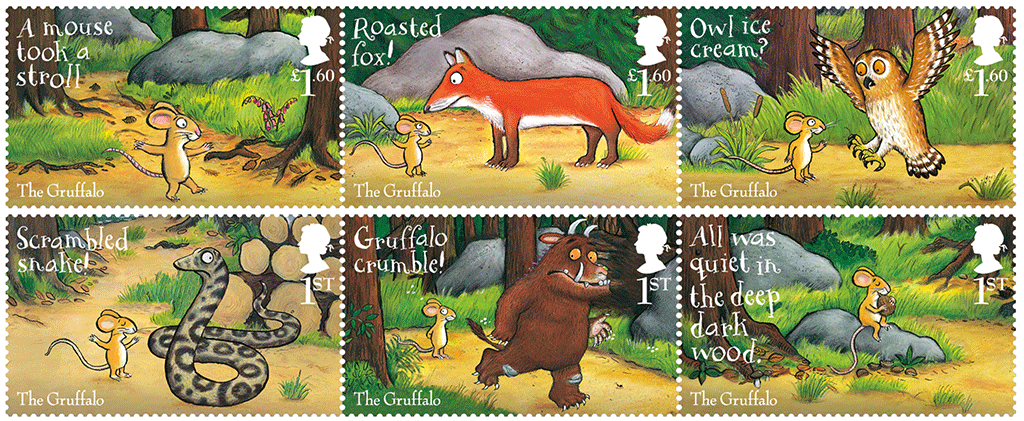 The Gruffalo has won numerous awards; it was the UK’s best-selling picture book of 2000, won the Blue Peter Best Book To Read Aloud award and was voted Best Bedtime Story in
The Gruffalo has won numerous awards; it was the UK’s best-selling picture book of 2000, won the Blue Peter Best Book To Read Aloud award and was voted Best Bedtime Story in 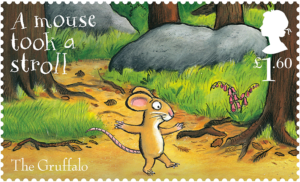 a BBC poll of 2009. It has been adapted into theatre productions with runs in the West End, Broadway and the Sydney Opera House. It has also been adapted into an Oscar nominated, animated film.
a BBC poll of 2009. It has been adapted into theatre productions with runs in the West End, Broadway and the Sydney Opera House. It has also been adapted into an Oscar nominated, animated film.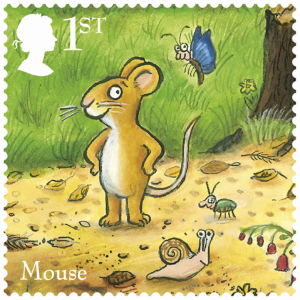 A full set of all 10 stamps, available in a Presentation Pack (which includes a Gruffalo snakes and ladders game), retails at £12.20.
A full set of all 10 stamps, available in a Presentation Pack (which includes a Gruffalo snakes and ladders game), retails at £12.20.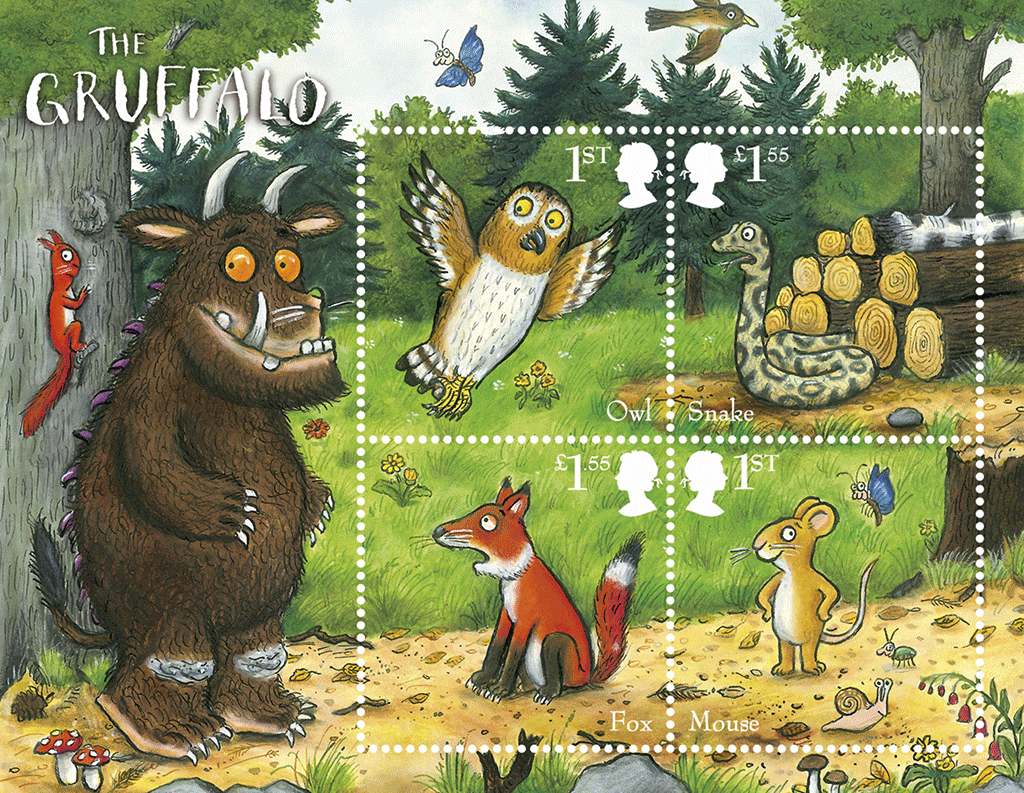
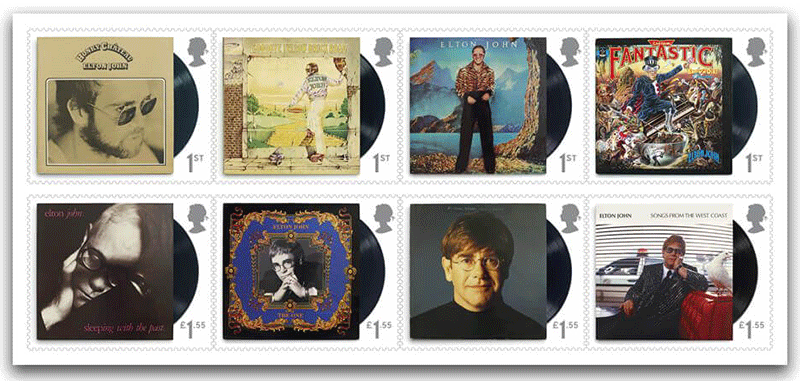
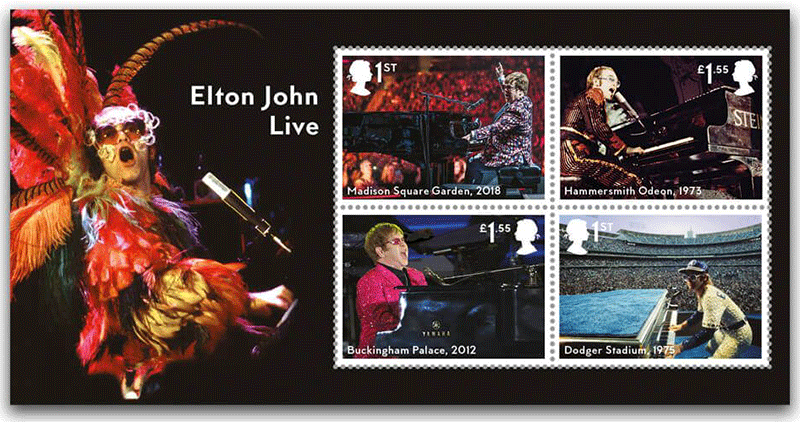
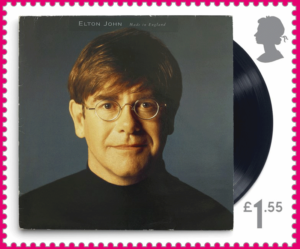 A global superstar, Elton John is one of the most successful recording artists of all time and has, over his 50-year career, achieved one diamond, 38 platinum or multi-platinum and 26 gold albums. He has been awarded 13 Ivor Novellos, five Grammys and the Grammy Legend Award, five BRITS, including the first BRITS Icon Award, an Academy Award, a Tony Award and a Golden Globe.
A global superstar, Elton John is one of the most successful recording artists of all time and has, over his 50-year career, achieved one diamond, 38 platinum or multi-platinum and 26 gold albums. He has been awarded 13 Ivor Novellos, five Grammys and the Grammy Legend Award, five BRITS, including the first BRITS Icon Award, an Academy Award, a Tony Award and a Golden Globe.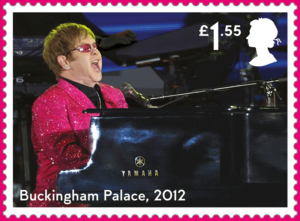 He has been deeply influential to successive generations of songwriters. His work has been covered by hundreds of artists in different genres, from Ed Sheeran to Aretha Franklin to Lady Ga Ga.
He has been deeply influential to successive generations of songwriters. His work has been covered by hundreds of artists in different genres, from Ed Sheeran to Aretha Franklin to Lady Ga Ga.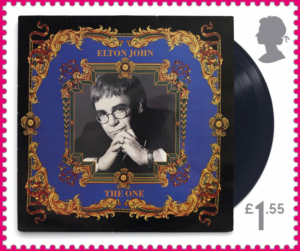 Elton John, said: “To say I was surprised when Royal Mail got in touch, is an understatement. Never did I think I’d appear on a stamp! It’s wonderful, a great honour.”
Elton John, said: “To say I was surprised when Royal Mail got in touch, is an understatement. Never did I think I’d appear on a stamp! It’s wonderful, a great honour.” The stamps and a range of unique collectible products including frames and prints are available from
The stamps and a range of unique collectible products including frames and prints are available from 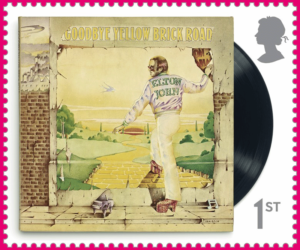 platinum, and 26 gold albums, over 50 Top 40 hits, and he has sold more than 300 million records worldwide. He holds the record for the biggest-selling single of all time, “Candle in the Wind 1997”, which sold over 33 million copies. Diamonds the Ultimate Greatest Hits album, reached the Top 5 of the UK album charts on its release in November 2017, becoming Elton’s 40th UK Top 40 album in the process. This release celebrated 50 years of his song writing partnership with Bernie Taupin. August 2018 saw Elton named as the most successful male solo artist in Billboard Hot 100 chart history, having logged 67 entries, including nine No. 1s and 27 Top 10s.
platinum, and 26 gold albums, over 50 Top 40 hits, and he has sold more than 300 million records worldwide. He holds the record for the biggest-selling single of all time, “Candle in the Wind 1997”, which sold over 33 million copies. Diamonds the Ultimate Greatest Hits album, reached the Top 5 of the UK album charts on its release in November 2017, becoming Elton’s 40th UK Top 40 album in the process. This release celebrated 50 years of his song writing partnership with Bernie Taupin. August 2018 saw Elton named as the most successful male solo artist in Billboard Hot 100 chart history, having logged 67 entries, including nine No. 1s and 27 Top 10s. Elton announced the Farewell Yellow Brick Road tour at New York’s Gotham Hall in January 2018. Encompassing 5 continents, and over 350 dates, this 3-year-long tour started in September 2018 and marks his retirement from touring after more than 50 years on the road. In May 2019 it was named Billboard’s Top Rock Tour. To date, Elton has delivered more than 4,000 performances in more than 80 countries since launching his first tour in 1970. 2019 has already seen the release of ‘Rocketman’, a fantasy musical motion picture of his life and his autobiography Me will be published later in the year.
Elton announced the Farewell Yellow Brick Road tour at New York’s Gotham Hall in January 2018. Encompassing 5 continents, and over 350 dates, this 3-year-long tour started in September 2018 and marks his retirement from touring after more than 50 years on the road. In May 2019 it was named Billboard’s Top Rock Tour. To date, Elton has delivered more than 4,000 performances in more than 80 countries since launching his first tour in 1970. 2019 has already seen the release of ‘Rocketman’, a fantasy musical motion picture of his life and his autobiography Me will be published later in the year.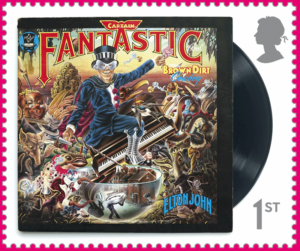 Among the many awards and honours bestowed upon him are six GRAMMYs, including a GRAMMY Legend award, a Tony and an Oscar, a Best British Male Artist BRIT Award, induction into the Rock and Roll Hall of Fame and the Songwriters Hall of Fame, the Kennedy Center Honor, Legend of Live Award, 13 Ivor Novello Awards between 1973 and 2001and a knighthood from HM Queen Elizabeth II for “services to music and charitable services.”
Among the many awards and honours bestowed upon him are six GRAMMYs, including a GRAMMY Legend award, a Tony and an Oscar, a Best British Male Artist BRIT Award, induction into the Rock and Roll Hall of Fame and the Songwriters Hall of Fame, the Kennedy Center Honor, Legend of Live Award, 13 Ivor Novello Awards between 1973 and 2001and a knighthood from HM Queen Elizabeth II for “services to music and charitable services.”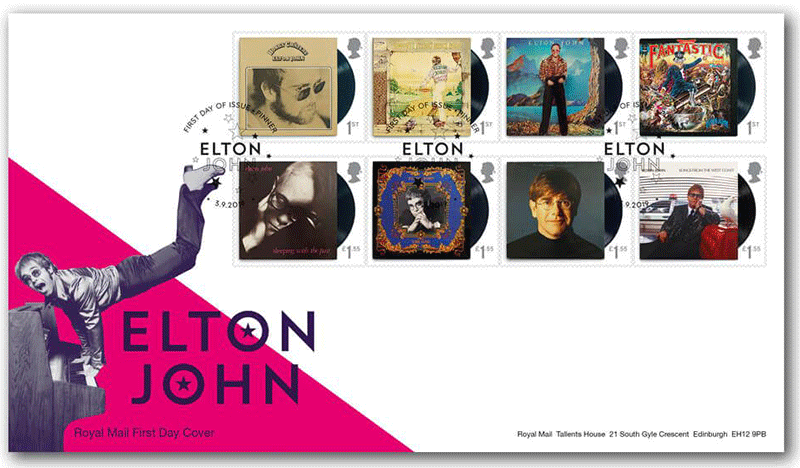
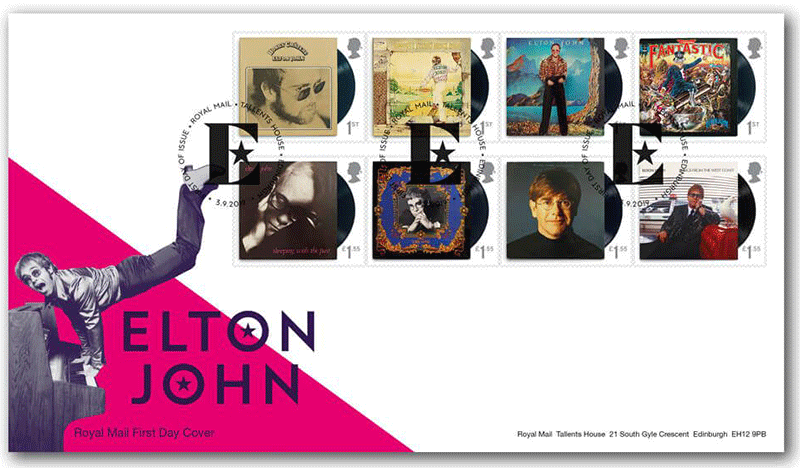
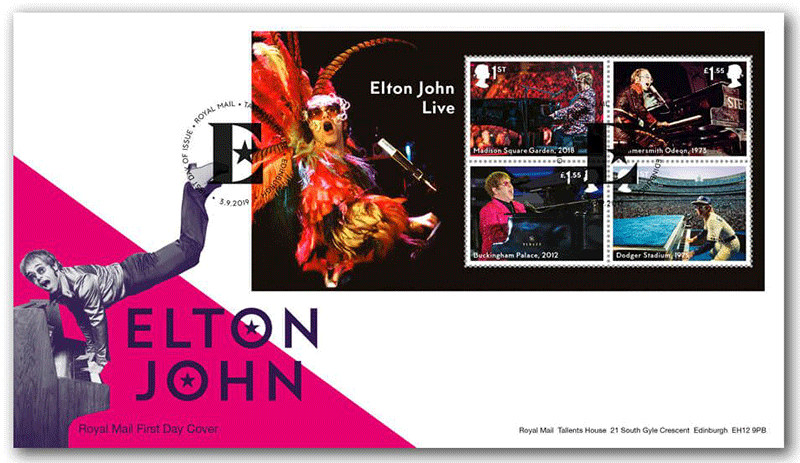
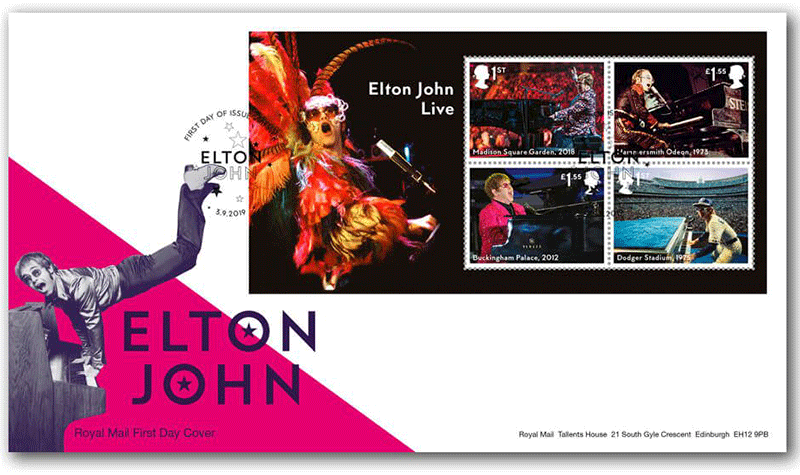 more products:
more products: 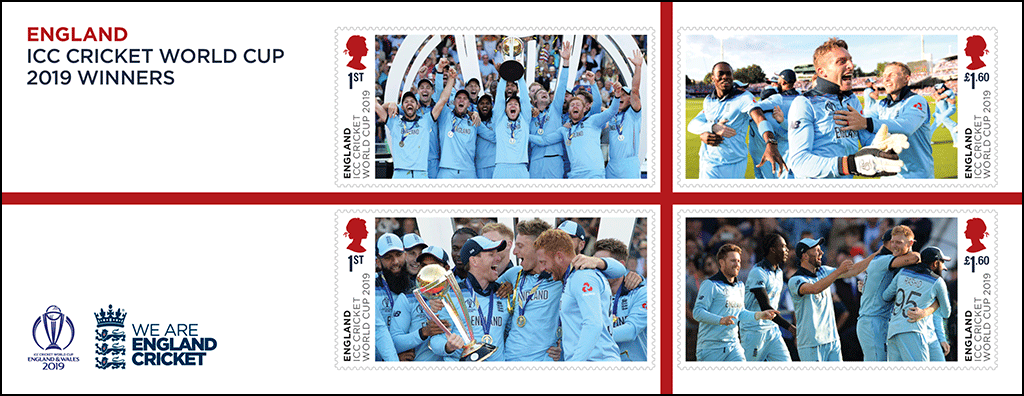
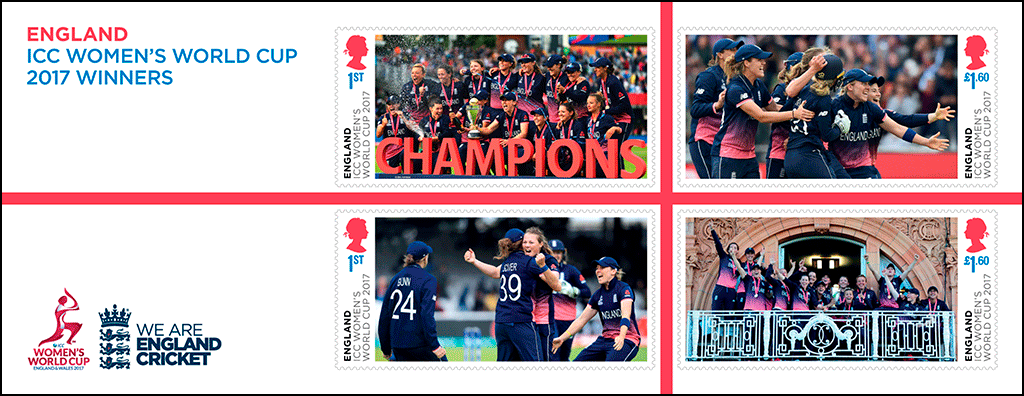
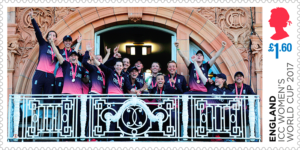
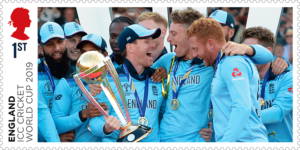 be presented in two Miniature Sheets
be presented in two Miniature Sheets host to the 2019 men’s and 2017 women’s tournaments. The paintwork will be in place for three months and will be complemented by a permanent gold plaque
host to the 2019 men’s and 2017 women’s tournaments. The paintwork will be in place for three months and will be complemented by a permanent gold plaque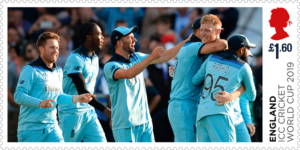 The men’s Miniature Sheet comprises four stamps; each capturing a moment of celebration following England’s thrilling World Cup Final victory against New Zealand at Lord’s Cricket Ground.
The men’s Miniature Sheet comprises four stamps; each capturing a moment of celebration following England’s thrilling World Cup Final victory against New Zealand at Lord’s Cricket Ground.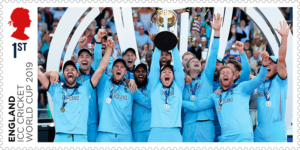 Each sheet will include two 1st Class stamps, alongside two £1.60 value stamps and retail at £4.60. Fans can pre-order the stamps now; online at
Each sheet will include two 1st Class stamps, alongside two £1.60 value stamps and retail at £4.60. Fans can pre-order the stamps now; online at  Royal Mail has also decorated 15 special edition postboxes at each venue used in the tournament to mark the historic achievement of both England teams. The first postbox painted was outside Lord’s Cricket Ground where both sold-out finals were held.
Royal Mail has also decorated 15 special edition postboxes at each venue used in the tournament to mark the historic achievement of both England teams. The first postbox painted was outside Lord’s Cricket Ground where both sold-out finals were held.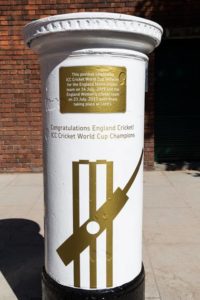 Bristol County Ground – Bristol
Bristol County Ground – Bristol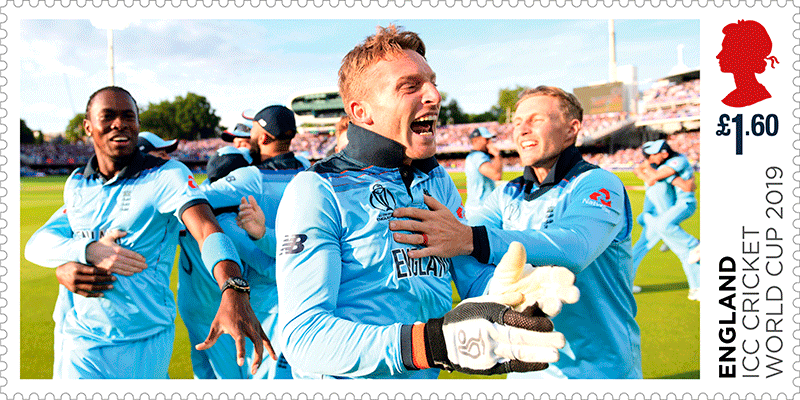
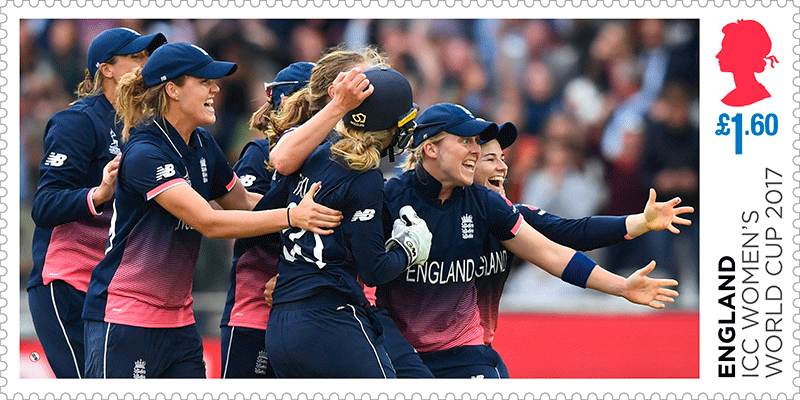
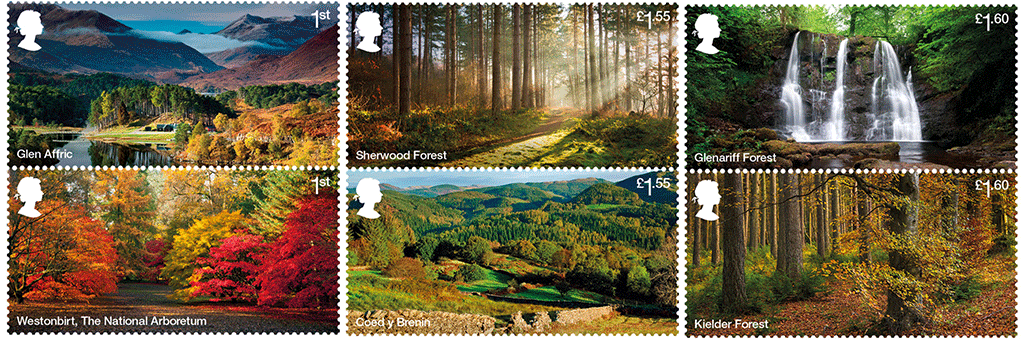
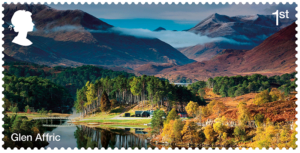 Glen Affric in Inverness-shire, is managed by Forestry and Land Scotland and is a fragment of the once extensive Caledonian Forest. Its rugged Scots pines and graceful birches are the signature trees in a landscape where forest, lochs, river and mountains combine to create the perfect Highland setting, which is breath-taking at any time of year but especially when the birches take on their golden apparel.
Glen Affric in Inverness-shire, is managed by Forestry and Land Scotland and is a fragment of the once extensive Caledonian Forest. Its rugged Scots pines and graceful birches are the signature trees in a landscape where forest, lochs, river and mountains combine to create the perfect Highland setting, which is breath-taking at any time of year but especially when the birches take on their golden apparel.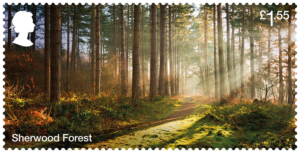 Sherwood Forest in Nottinghamshire is famous for its rich assemblage of ancient oak trees, such as the Major Oak. The atmospheric image on the stamp shows a fine stand of conifers in the early morning light, reflecting the mixed planting found across the whole forest.
Sherwood Forest in Nottinghamshire is famous for its rich assemblage of ancient oak trees, such as the Major Oak. The atmospheric image on the stamp shows a fine stand of conifers in the early morning light, reflecting the mixed planting found across the whole forest.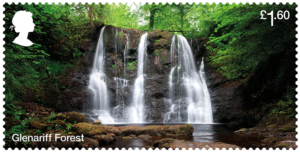 Managed by the Forest Service Northern Ireland, Glenariff Forest Park in County Antrim, boasts a beautiful mixture of views and trails that allow the visitor to enjoy a wide variety of walks and activities. Probably the most spectacular of these is the Waterfall Walk, a steep path up the vertical sides of the gorge and along elevated boardwalks taking in a succession of dramatic and world-famous waterfalls.
Managed by the Forest Service Northern Ireland, Glenariff Forest Park in County Antrim, boasts a beautiful mixture of views and trails that allow the visitor to enjoy a wide variety of walks and activities. Probably the most spectacular of these is the Waterfall Walk, a steep path up the vertical sides of the gorge and along elevated boardwalks taking in a succession of dramatic and world-famous waterfalls.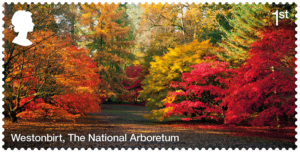 Westonbirt, The National Arboretum is the Forestry Commission’s flagship collection of trees in England. First created by the wealthy Holford family almost 200 years ago, it is one of the most beautiful and diverse botanical collections in the world. The 600-acre (243ha) site with 17 miles (27km) of paths showcases 3,000 tree species, including the Japanese maples seen on the stamp in autumnal colours.
Westonbirt, The National Arboretum is the Forestry Commission’s flagship collection of trees in England. First created by the wealthy Holford family almost 200 years ago, it is one of the most beautiful and diverse botanical collections in the world. The 600-acre (243ha) site with 17 miles (27km) of paths showcases 3,000 tree species, including the Japanese maples seen on the stamp in autumnal colours.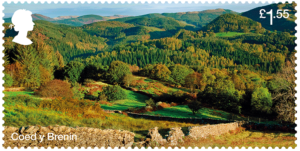 Located near Dolgellau in the Snowdonia National Park, Coed y Brenin is now one of the flagship forests of Natural Resources Wales. Commercial softwood forestry across some 7,650 acres (3,093ha) of Forest Park combines with recreational facilities for mountain-bikers and a network of spectacular scenic trails for hikers, based around the impressive visitor centre.
Located near Dolgellau in the Snowdonia National Park, Coed y Brenin is now one of the flagship forests of Natural Resources Wales. Commercial softwood forestry across some 7,650 acres (3,093ha) of Forest Park combines with recreational facilities for mountain-bikers and a network of spectacular scenic trails for hikers, based around the impressive visitor centre.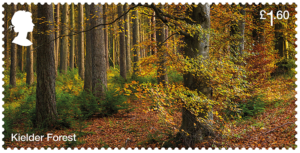 Kielder Forest in Northumberland is the largest human-made forest in Britain, stretching 250 square miles (647sq km); around 75 per cent is covered by trees. The Forestry Commission harvests around 500,000 cubic metres of timber here each year. The felled areas are replanted using a mixture of conifer and broadleaf trees, and parts are left open to create a diversity of habitats.
Kielder Forest in Northumberland is the largest human-made forest in Britain, stretching 250 square miles (647sq km); around 75 per cent is covered by trees. The Forestry Commission harvests around 500,000 cubic metres of timber here each year. The felled areas are replanted using a mixture of conifer and broadleaf trees, and parts are left open to create a diversity of habitats.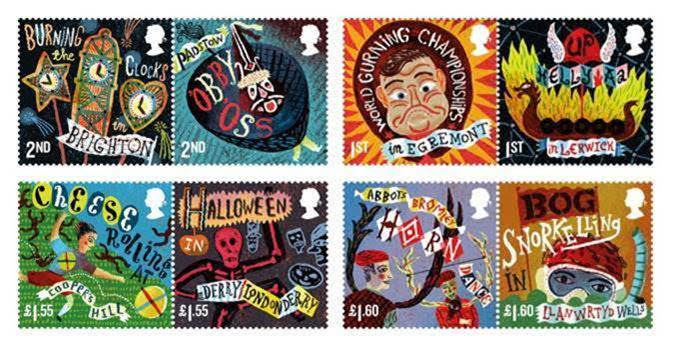 Royal Mail has revealed eight colourful and engaging illustrations, depicting and capturing the spirit of well-known, and some not so well-known, annual customs that take place around the UK. The stamps celebrate the eclectic mix of annual customs and festivals that take place across the UK. Royal Mail worked with award-winning folklorist Steve Roud on the stamp issue
Royal Mail has revealed eight colourful and engaging illustrations, depicting and capturing the spirit of well-known, and some not so well-known, annual customs that take place around the UK. The stamps celebrate the eclectic mix of annual customs and festivals that take place across the UK. Royal Mail worked with award-winning folklorist Steve Roud on the stamp issue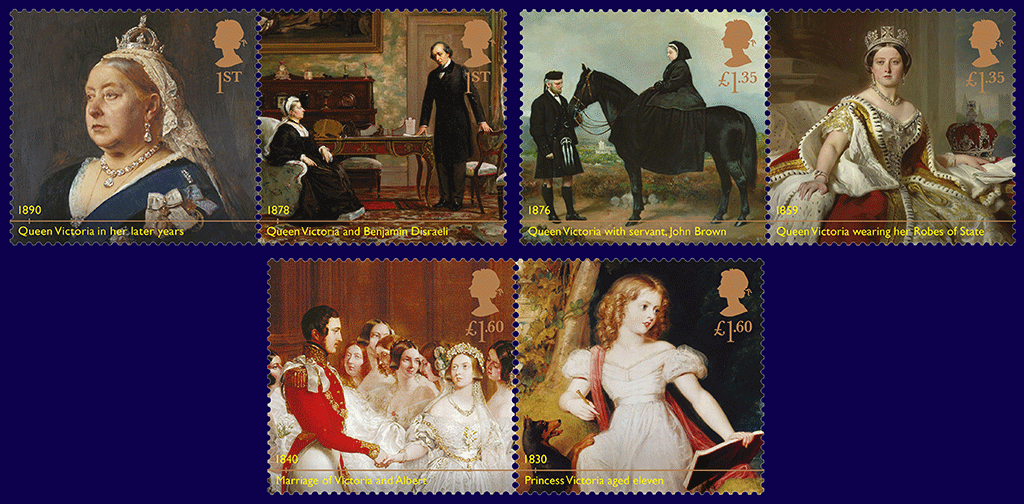
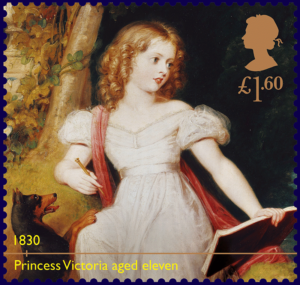 Stamps AS4583 £7.30
Stamps AS4583 £7.30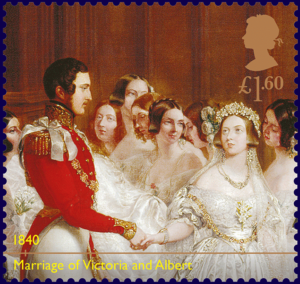 Design: Webb & Webb Design
Design: Webb & Webb Design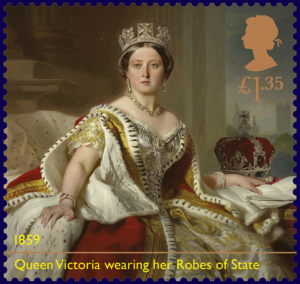 Victoria when a Girl by Richard Westall, Royal Collection Trust/© Her Majesty Queen Elizabeth II 2019
Victoria when a Girl by Richard Westall, Royal Collection Trust/© Her Majesty Queen Elizabeth II 2019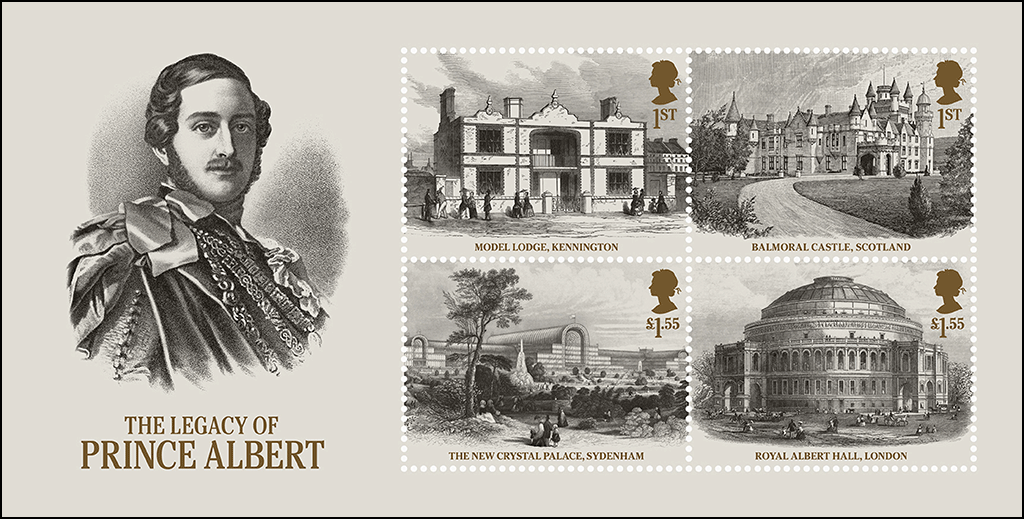
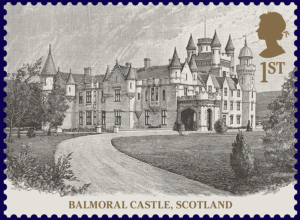 Acknowledgements: Background image – Albert Prince Consort © Hulton Fine Art Collection/Getty Images; Model Lodge, Kennington, Private Collection/© Look and Learn/Illustrated Papers Collection/Bridgeman Images; Balmoral Castle, Scotland, Private Collection/© Look and Learn/Bridgeman Images; The New Crystal Palace, Sydenham © Science & Society Picture Library/Getty Images; Royal Albert Hall, London, Private Collection/© Look and Learn/Peter Jackson Collection/Bridgeman Images
Acknowledgements: Background image – Albert Prince Consort © Hulton Fine Art Collection/Getty Images; Model Lodge, Kennington, Private Collection/© Look and Learn/Illustrated Papers Collection/Bridgeman Images; Balmoral Castle, Scotland, Private Collection/© Look and Learn/Bridgeman Images; The New Crystal Palace, Sydenham © Science & Society Picture Library/Getty Images; Royal Albert Hall, London, Private Collection/© Look and Learn/Peter Jackson Collection/Bridgeman Images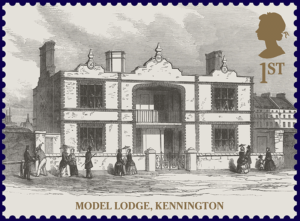 Miniature sheet size: 146mm x 74mm
Miniature sheet size: 146mm x 74mm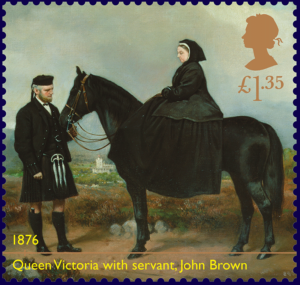 The Presentation Pack contains all six special stamps plus the Legacy of Prince Albert miniature sheet in a separate carrier. The pack includes an illustrated biography of Queen Victoria reflecting on her life on one side and her long period of mourning following the death of Prince Albert on the other.
The Presentation Pack contains all six special stamps plus the Legacy of Prince Albert miniature sheet in a separate carrier. The pack includes an illustrated biography of Queen Victoria reflecting on her life on one side and her long period of mourning following the death of Prince Albert on the other.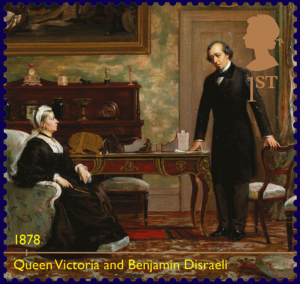
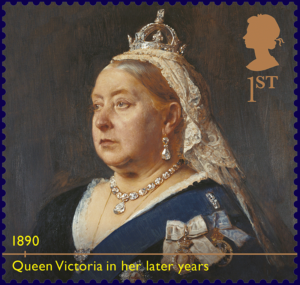
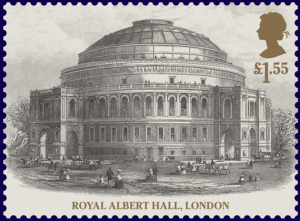
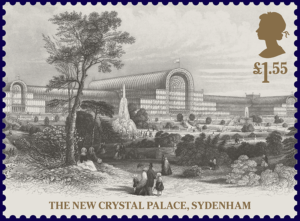
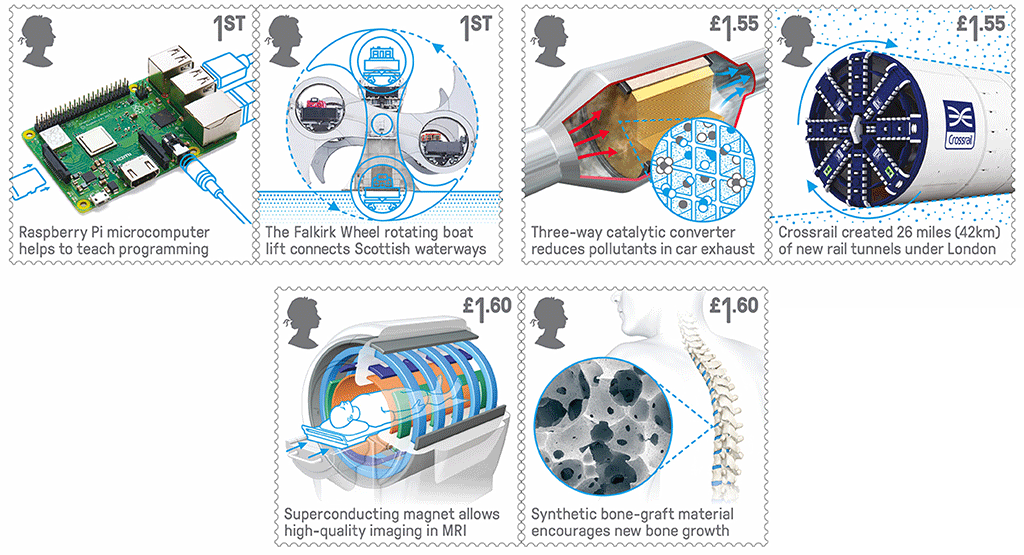
 Royal Mail has revealed 10 new Special Stamps to mark Britain’s long and proud history of engineering excellence.
Royal Mail has revealed 10 new Special Stamps to mark Britain’s long and proud history of engineering excellence. A collaboration of British engineers and architects produced the world’s first and only rotating boat lift, The Falkirk Wheel, joining two major Scottish canals for the first time in 70 years with a phenomenally beautiful structure.
A collaboration of British engineers and architects produced the world’s first and only rotating boat lift, The Falkirk Wheel, joining two major Scottish canals for the first time in 70 years with a phenomenally beautiful structure.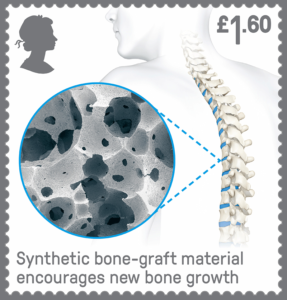 prevent some 20 million tonnes of pollutants from entering the atmosphere, helping to make the world cleaner and healthier.”
prevent some 20 million tonnes of pollutants from entering the atmosphere, helping to make the world cleaner and healthier.”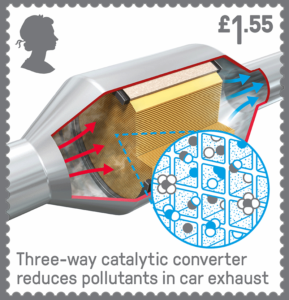 The team at Queen Mary University of London led by Dr Karin Hing, engineered materials that encourage bone growth when used in complex orthopaedic surgeries and have improved the outcomes for hundreds of thousands of patients worldwide.
The team at Queen Mary University of London led by Dr Karin Hing, engineered materials that encourage bone growth when used in complex orthopaedic surgeries and have improved the outcomes for hundreds of thousands of patients worldwide.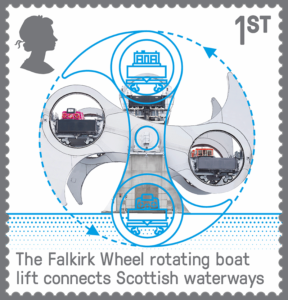 people’s lives, but this would not have been possible without multidisciplinary collaboration. Having our engineering of synthetic bone grafts celebrated on a stamp like the Marvel Comics and the Harry Potter books might even impress my kids.”
people’s lives, but this would not have been possible without multidisciplinary collaboration. Having our engineering of synthetic bone grafts celebrated on a stamp like the Marvel Comics and the Harry Potter books might even impress my kids.”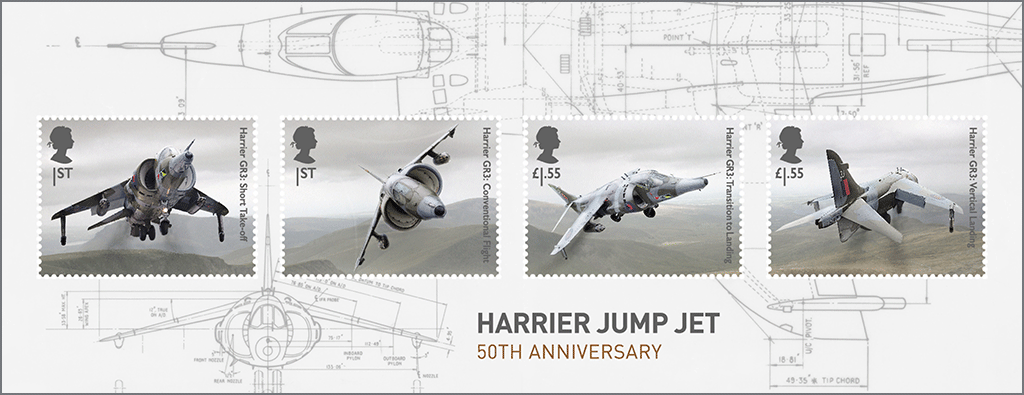
 Some of the innovations celebrated have won the MacRobert Award, bestowed by the Royal Academy of Engineering – the UK’s most prestigious and longest running award for engineering excellence. The award marks its 50th birthday this year.Dr Dame Sue Ion DBE FREng FRS, Chair of Judges for the Royal Academy of Engineering MacRobert Award, said: “The UK is a global engineering powerhouse with many world firsts developed here that have both benefitted our economy and helped to transform people’s lives for the better. This wonderful new set of Royal Mail stamps perfectly encapsulates the technical and commercial achievements made by British engineers over the last 50 years, from the Harrier jump jet to Raspberry Pi. These great British engineering innovations – several of which have won the MacRobert Award, the UK’s biggest prize for engineering innovation – represent an amazing foundation from which to develop exciting technologies for the future.”Philip Parker, Royal Mail, said: “British innovation in engineering is world renowned. This stamp issue proudly celebrates the projects and inventions which showcase this, as well as demonstrating the extraordinary range of disciplines that British engineers excel in.”
Some of the innovations celebrated have won the MacRobert Award, bestowed by the Royal Academy of Engineering – the UK’s most prestigious and longest running award for engineering excellence. The award marks its 50th birthday this year.Dr Dame Sue Ion DBE FREng FRS, Chair of Judges for the Royal Academy of Engineering MacRobert Award, said: “The UK is a global engineering powerhouse with many world firsts developed here that have both benefitted our economy and helped to transform people’s lives for the better. This wonderful new set of Royal Mail stamps perfectly encapsulates the technical and commercial achievements made by British engineers over the last 50 years, from the Harrier jump jet to Raspberry Pi. These great British engineering innovations – several of which have won the MacRobert Award, the UK’s biggest prize for engineering innovation – represent an amazing foundation from which to develop exciting technologies for the future.”Philip Parker, Royal Mail, said: “British innovation in engineering is world renowned. This stamp issue proudly celebrates the projects and inventions which showcase this, as well as demonstrating the extraordinary range of disciplines that British engineers excel in.”
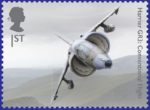 The Hawker Siddeley Harrier was developed from a unique experimental aircraft known as the P 1127, which was capable of taking off and landing vertically. In 1962, British, US and German armed forces procured nine of these aircraft to form a Tri-Partite Evaluation Squadron at RAF West Raynham. Now called Kestrels, these aircraft could take off and land using paved runways, semi-prepared sites in clearings in woods and other confined
The Hawker Siddeley Harrier was developed from a unique experimental aircraft known as the P 1127, which was capable of taking off and landing vertically. In 1962, British, US and German armed forces procured nine of these aircraft to form a Tri-Partite Evaluation Squadron at RAF West Raynham. Now called Kestrels, these aircraft could take off and land using paved runways, semi-prepared sites in clearings in woods and other confined 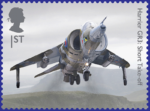 spaces.
spaces.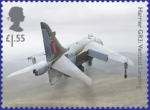 extremely effective ground attack. They could drop precision-guided weapons and operate in poor weather using the latest radar, infrared and optical devices. Because of their remarkable take-off ability, they became known as Harrier Jump Jets.
extremely effective ground attack. They could drop precision-guided weapons and operate in poor weather using the latest radar, infrared and optical devices. Because of their remarkable take-off ability, they became known as Harrier Jump Jets.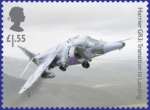 Academy of Engineering in 1969. Photographer Richard Cook captured a Harrier GR3 especially for the stamps.
Academy of Engineering in 1969. Photographer Richard Cook captured a Harrier GR3 especially for the stamps.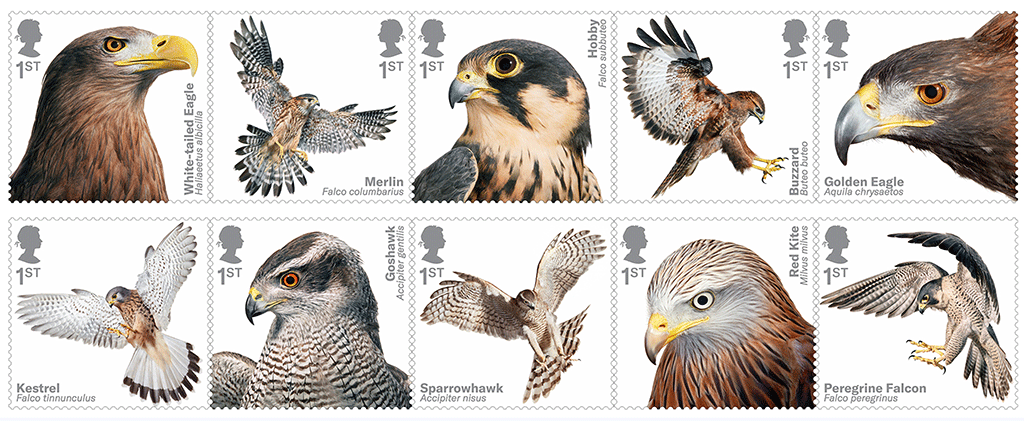 Products/Price/Code
Products/Price/Code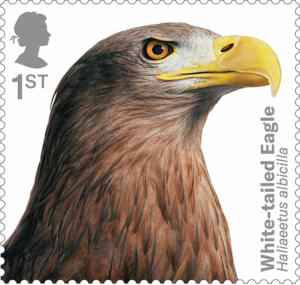 This very large eagle catches fish or sea birds with a low, slow approach, dropping its feet into the water to snatch the prey and then taking it to shore. These eagles were persecuted to extinction by 1918, but in 1975 a release programme was started on R˘m in Scotland. The population in Scotland is now around 60 breeding pairs, with over 200 adult birds. Since eagles readily feed on carrion, they get blamed for killing animals they are unlikely to kill. The financial benefit to Scotland from tourists coming to photograph these stunning birds is approximately £5 million a year.
This very large eagle catches fish or sea birds with a low, slow approach, dropping its feet into the water to snatch the prey and then taking it to shore. These eagles were persecuted to extinction by 1918, but in 1975 a release programme was started on R˘m in Scotland. The population in Scotland is now around 60 breeding pairs, with over 200 adult birds. Since eagles readily feed on carrion, they get blamed for killing animals they are unlikely to kill. The financial benefit to Scotland from tourists coming to photograph these stunning birds is approximately £5 million a year.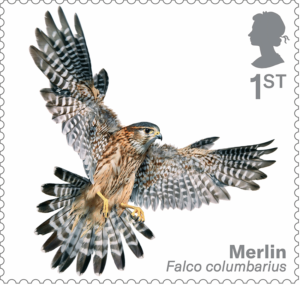 The merlin, which belongs to the falcon family, is the smallest UK raptor and can be found during the spring and summer on the uplands, nesting on the ground underneath heather. A specialist bird-catcher, it feeds its young on larks and meadow pipits in the summer. Females are brown, as are juveniles, while adult males have a blue-grey back. Once the autumn arrives, these birds move to lowlands, in a partial migration, for the winter. Since merlins are fast, agile and small, they are not commonly seen, but energetic young make a spectacular ringing flight after larks.
The merlin, which belongs to the falcon family, is the smallest UK raptor and can be found during the spring and summer on the uplands, nesting on the ground underneath heather. A specialist bird-catcher, it feeds its young on larks and meadow pipits in the summer. Females are brown, as are juveniles, while adult males have a blue-grey back. Once the autumn arrives, these birds move to lowlands, in a partial migration, for the winter. Since merlins are fast, agile and small, they are not commonly seen, but energetic young make a spectacular ringing flight after larks.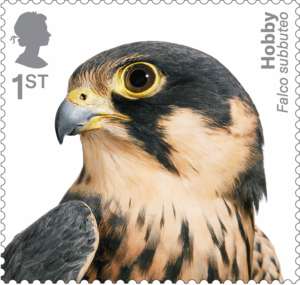 Larger than the merlin, this little falcon migrates to the UK from Africa in the spring to breed. With its long, sickle-shaped wings, it resembles a giant swift and is incredibly nimble in flight. Feeding on dragonflies and other insects, the hobby is often seen near large bodies of water. It nests using abandoned crowsí nests, and during the breeding season it hunts for swallows and swifts to feed its young. Once the young are able to fly and can hunt for themselves, hobbies migrate with the swallows back to Africa.
Larger than the merlin, this little falcon migrates to the UK from Africa in the spring to breed. With its long, sickle-shaped wings, it resembles a giant swift and is incredibly nimble in flight. Feeding on dragonflies and other insects, the hobby is often seen near large bodies of water. It nests using abandoned crowsí nests, and during the breeding season it hunts for swallows and swifts to feed its young. Once the young are able to fly and can hunt for themselves, hobbies migrate with the swallows back to Africa.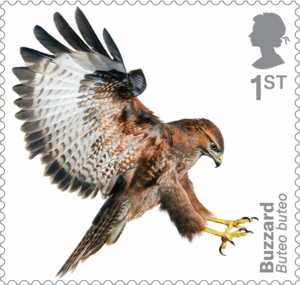 By the 1970s, the common (or Eurasian) buzzard was rare in the UK other than in the far west. Since then, however, there has been a huge increase thanks to more nesting areas and to rabbits surviving myxomatosis, and buzzards are now breeding in every county. Buzzards are usually seen on fi ne days soaring and calling, with a mewing cry, or sitting on poles, on fences by roads or on the ground, particularly when ploughed in the winter. They scavenge roadkill, which can cause them traffic injuries, or feed on insects on the ground. There is enormous colour variation in this species, from almost all cream to very dark brown.
By the 1970s, the common (or Eurasian) buzzard was rare in the UK other than in the far west. Since then, however, there has been a huge increase thanks to more nesting areas and to rabbits surviving myxomatosis, and buzzards are now breeding in every county. Buzzards are usually seen on fi ne days soaring and calling, with a mewing cry, or sitting on poles, on fences by roads or on the ground, particularly when ploughed in the winter. They scavenge roadkill, which can cause them traffic injuries, or feed on insects on the ground. There is enormous colour variation in this species, from almost all cream to very dark brown.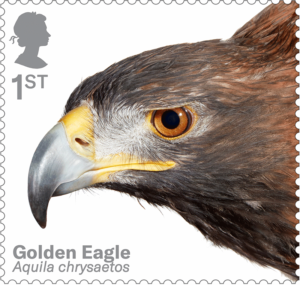 The golden eagle prefers remote moorlands and mountains in Scotland, usually nesting on cliff ledges. It soars over the Highlands, catching rabbits, hares and birds with its very powerful feet. It also consumes carrion, in some areas being reliant on dead animals during the winter. Golden eagles pair for life. Of the two eggs that the female lays, one chick rarely survives, the other fl edging at about three-and-a-half months. Juveniles have a mottled white and brown tail with a black band, which turns brown over the years. The golden feathers that give this eagle its name are on the head and the neck.
The golden eagle prefers remote moorlands and mountains in Scotland, usually nesting on cliff ledges. It soars over the Highlands, catching rabbits, hares and birds with its very powerful feet. It also consumes carrion, in some areas being reliant on dead animals during the winter. Golden eagles pair for life. Of the two eggs that the female lays, one chick rarely survives, the other fl edging at about three-and-a-half months. Juveniles have a mottled white and brown tail with a black band, which turns brown over the years. The golden feathers that give this eagle its name are on the head and the neck.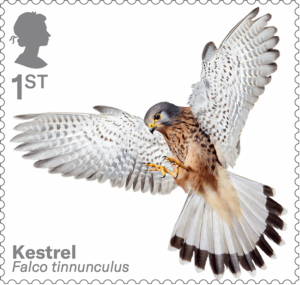 Once the UKís most common raptor, observed hovering by roads and motorways, this falcon has seen a decrease of 40 per cent over the past two decades. A key reason for the decline is the lack of sufficient nest sites and suitable grasslands for hunting. Kestrels are characterised by a beautiful chestnut-red colour over their bodies. The female has a red tail with bars, while the adult male has a grey head and grey tail with a black band at its tip. These birds are best known for hunting mice and voles by hovering, often descending in stages to drop on their prey.
Once the UKís most common raptor, observed hovering by roads and motorways, this falcon has seen a decrease of 40 per cent over the past two decades. A key reason for the decline is the lack of sufficient nest sites and suitable grasslands for hunting. Kestrels are characterised by a beautiful chestnut-red colour over their bodies. The female has a red tail with bars, while the adult male has a grey head and grey tail with a black band at its tip. These birds are best known for hunting mice and voles by hovering, often descending in stages to drop on their prey.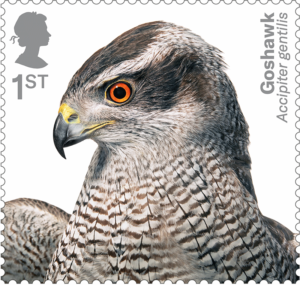 This aggressive, forest-dwelling hunter was probably extinct as a breeder until the middle of the 20th century. Its wing shape allows it to twist and turn through trees, and its long legs and powerful feet are well suited to hunting birds and mammals up to the size of a hare, with a short, often surprise attack. Adults are grey and white, with fi ne horizontal bars on the breast, while juveniles are brown, with vertical brown stripes. Goshawks build large stick nests and lay up to four eggs. The parents are vocal in the spring, when they can sometimes be seen soaring high in good weather.
This aggressive, forest-dwelling hunter was probably extinct as a breeder until the middle of the 20th century. Its wing shape allows it to twist and turn through trees, and its long legs and powerful feet are well suited to hunting birds and mammals up to the size of a hare, with a short, often surprise attack. Adults are grey and white, with fi ne horizontal bars on the breast, while juveniles are brown, with vertical brown stripes. Goshawks build large stick nests and lay up to four eggs. The parents are vocal in the spring, when they can sometimes be seen soaring high in good weather.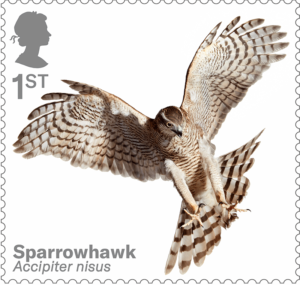 This little hawk is most commonly seen in gardens catching small birds. Its defining features are very long, thin legs and yellow eyes. Males are tiny in comparison to females. Both hunt birds, but females can take birds up to the size of a pigeon. The sparrowhawk is often blamed, wrongly, for the demise of small birds, while in fact it is cats, cars, windows and pesticides that are responsible. Sparrowhawks build a stick nest and rear up to five young. The young grow swiftly and become independent by the age of 14 weeks, although onlyabout a third survive their first year.
This little hawk is most commonly seen in gardens catching small birds. Its defining features are very long, thin legs and yellow eyes. Males are tiny in comparison to females. Both hunt birds, but females can take birds up to the size of a pigeon. The sparrowhawk is often blamed, wrongly, for the demise of small birds, while in fact it is cats, cars, windows and pesticides that are responsible. Sparrowhawks build a stick nest and rear up to five young. The young grow swiftly and become independent by the age of 14 weeks, although onlyabout a third survive their first year.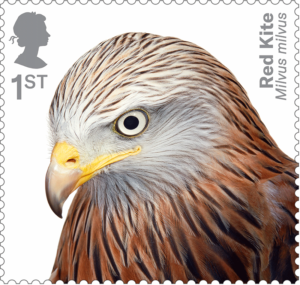 By 1903, red kites had been persecuted close to extinction, with the last few remaining in the mountains of Wales, when a farmer started to feed them. Now, with four feeding stations, there are 900 pairs in Wales. There have been very successful translocation programmes in England, Scotland and Northern Ireland, so kites are now seen soaring together in many places. Long wings, a long, forked tail and red colour make the red kite easy to identify. These birds are mainly scavengers, feeding on roadkill and animal remains. They have small feet for their body size, which limits the prey they can catch.
By 1903, red kites had been persecuted close to extinction, with the last few remaining in the mountains of Wales, when a farmer started to feed them. Now, with four feeding stations, there are 900 pairs in Wales. There have been very successful translocation programmes in England, Scotland and Northern Ireland, so kites are now seen soaring together in many places. Long wings, a long, forked tail and red colour make the red kite easy to identify. These birds are mainly scavengers, feeding on roadkill and animal remains. They have small feet for their body size, which limits the prey they can catch.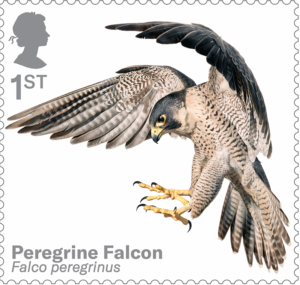 Brought to low numbers by pesticides in the middle of the 20th century, the peregrine has recovered dramatically. Many peregrines are now urban birds, nesting on cathedrals, other tall buildings and bridges. Probably the fastest living creature, the peregrine hunts birds up to the size of large gulls, almost always on the wing. It has a short tail and long, pointed wings. The juveniles are brown, while the adults have a grey-blue back. In the UK, these birds are sedentary, but peregrines in other areas can be migratory, and they are the most widely spread raptors worldwide.
Brought to low numbers by pesticides in the middle of the 20th century, the peregrine has recovered dramatically. Many peregrines are now urban birds, nesting on cathedrals, other tall buildings and bridges. Probably the fastest living creature, the peregrine hunts birds up to the size of large gulls, almost always on the wing. It has a short tail and long, pointed wings. The juveniles are brown, while the adults have a grey-blue back. In the UK, these birds are sedentary, but peregrines in other areas can be migratory, and they are the most widely spread raptors worldwide.

